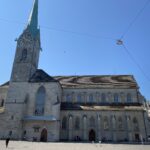
A church as old as Zurich’s Fraumünster has an abundance of art dating from the 9th century. I found two of these pieces particularly interesting in their artistic symbolism. Separated by about 500 years, the scenes show how differently artists interpret biblical stories over time. The older one interprets religious symbols via representations of actual figures; the more recent Chagall windows are abstracts of timeless spiritual stories.
Holy Trinity & Saints Felix & Regula
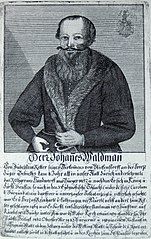
During the 15th century, Mayor Hans Waldmann donated a fresco to Fraumünster. Painted in the style of Flemish artist Robert Campin, Holy Trinity and Saints Felix and Regula once graced an outside wall. It now resides within the building.
When Mayor Waldmann imposed higher taxes on neighboring villages, five hundred peasants from Knonau removed him from office by separating his head from his body in 1489. However, it is possible Waldmann hoped that as his life on earth ended, God would reward him for his artistic donation to the church. [I had a professor once who suggested such donations were like cramming for finals.]
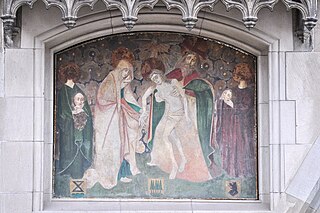
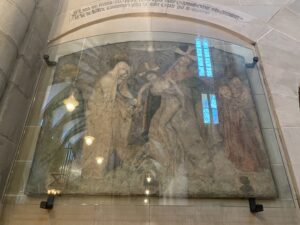
The Holy Trinity takes the center position of the mural. St. Mary, Patroness of Fraumünster, is shown on the left wearing a reddish cloak. As the Mater Dolorosa, she bows to God, the Father who is holding up Christ, and grasps her son’s hand. Next to Mary, Saints Felix and Regula, patrons of Zurich , stand as witnesses. God looks straight at the viewer. The Holy Spirit is the traditional dove centered at the top of the fresco.
At the bottom of the fresco, there are three coats of arms. Schwinger’s is on the left in honor of Waldmann’s mother. Waldmann’s coat of arms is in the middle. On the right is a coat of arms that probably belonged to Anna Landolt, Waldmann’s wife. Not only did Waldmann donate the window, he tied his family to the artistry.
The Chagall Windows
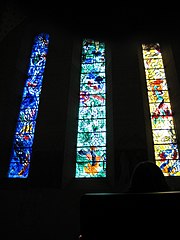
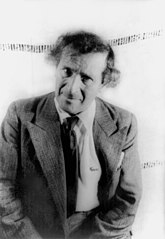
Fast forward about 500 years to the 1960s when members and leaders of Fraumünster began searching for an artist to create five colored glass windows for the eastern choir of the church. Seven years passed and no suitable artist had begun the work. Serendipitously, in 1967 Kunsthaus Zürich, the largest art museum in Switzerland, mounted an exhibit of Marc Chagall’s work. Church leaders approached the artist who agreed consider the project. Chagall sat in the church for several hours before saying the space inspired him. He accepted the project.
Chagall envisioned the space as an open area where people had enough room to fully enjoy the windows’ messages. In 1970 Chagall and his associate Charles Marq installed the five painted glass windows. With the exception of the Christ window, each window is 32 feet tall and 3 feet wide. Each has a different dominant color and illustrates a biblical story.

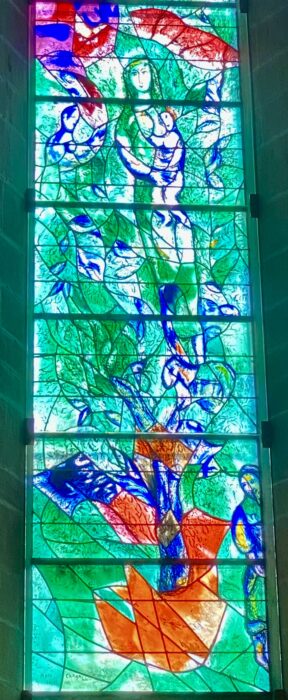
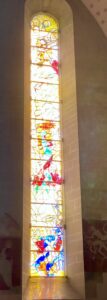
There are three windows on the eastern wall. On the left, Jacob’s Window, shows Jacob’s combat with the archangel Phanuel and his dream of climbing the ladder to heaven. In the center, Christ’s green window features scenes from Jesus’s life from birth through crucifixion. In the Zion Window on the right, angels trumpet the end of the world at the top while a New Jerusalem descends from heaven to earth.
The window of the Prophets is on the North wall. In orange and red hues, the window shows the prophet Elijah being taken into heaven by chariot while his successor Jeremiah watches. Across the choir, a deep blue window illustrates the story of Moses and the Ten Commandments.
Unlike the first example, Chagall beckons viewers into his abstract pictures. There are no coats of arms, only jewel toned colors inviting viewers to join in a somewhat surreal experience.
Before the pandemic, about 500,000 visitors a year paid five Swiss francs to visit Fraumünster. Many proceeded directly to Chagall’s windows. They spare few glances at the frescos in the south wall of the church transept where the artist captures Saints Felix & Regula achieving their martyrdom, and Princesses Hildegard & Berta in their dedication to God. But the art with its jewel-like colors isn’t placed in a key position within the church, and the images seem almost banal. Likewise, Waldmann’s fresco draws little interest. But Chagall’s windows in the eastern choir draw visitors with the fame of their artist and the intensity of his creation.
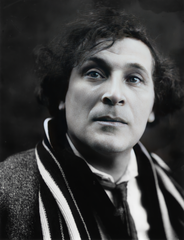
Cathedrals are repositories of material history. The artwork they host reveals the values of their creator artists. Values change over time, from sponsoring a fresco that hopes to bless a family or individual with God’s grace to engaging an artist to create a modern vision of a biblical past.
When I am finishing a picture, I hold some God-made object up to it — a rock, a flower, the branch of a tree or my hand — as a final test. If the painting stands up beside a thing man cannot make, the painting is authentic. If there’s a clash between the two, it’s bad art. — Marc Chagall
⛪️ ⛪️ ⛪️
Fresco on Facade of Frumünster by Sidonius.
Mark Chagall, 1941. Photo by Carl Van Vechten.
Stained Glass in Fraumünster by J. Doll.
Marc Chagall, 1920s.
Other Photos by Author
“The Stunning Chagall Windows in Zurich.” iTravelWithArt.
“On Site: Chagall Windows at Zurich’s Fraumünster Church.” LDR.

Sandra Wagner-Wright holds the doctoral degree in history and taught women’s and global history at the University of Hawai`i. Sandra travels for her research, most recently to Salem, Massachusetts, the setting of her new Salem Stories series. She also enjoys traveling for new experiences. Recent trips include Antarctica and a river cruise on the Rhine from Amsterdam to Basel.
Sandra particularly likes writing about strong women who make a difference. She lives in Hilo, Hawai`i with her family and writes a blog relating to history, travel, and the idiosyncrasies of life.

